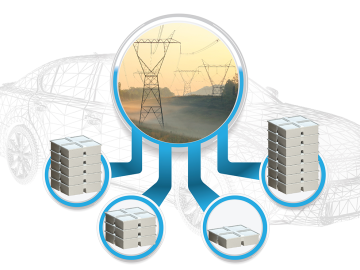
Filter News
Area of Research
News Topics
- (-) Grid (23)
- (-) Molten Salt (3)
- (-) Physics (27)
- (-) Space Exploration (6)
- (-) Transportation (33)
- 3-D Printing/Advanced Manufacturing (48)
- Advanced Reactors (17)
- Artificial Intelligence (34)
- Big Data (21)
- Bioenergy (35)
- Biology (34)
- Biomedical (29)
- Biotechnology (8)
- Buildings (15)
- Chemical Sciences (29)
- Clean Water (7)
- Composites (7)
- Computer Science (62)
- Coronavirus (29)
- Critical Materials (8)
- Cybersecurity (13)
- Education (3)
- Emergency (1)
- Energy Storage (42)
- Environment (72)
- Exascale Computing (18)
- Fossil Energy (2)
- Frontier (20)
- Fusion (22)
- High-Performance Computing (36)
- Hydropower (3)
- Irradiation (2)
- Isotopes (19)
- Machine Learning (23)
- Materials (61)
- Materials Science (53)
- Mathematics (4)
- Mercury (3)
- Microelectronics (2)
- Microscopy (15)
- Nanotechnology (24)
- National Security (23)
- Neutron Science (67)
- Nuclear Energy (52)
- Partnerships (24)
- Polymers (11)
- Quantum Computing (12)
- Quantum Science (23)
- Security (6)
- Simulation (29)
- Software (1)
- Summit (26)
Media Contacts

When aging vehicle batteries lack the juice to power your car anymore, they may still hold energy. Yet it’s tough to find new uses for lithium-ion batteries with different makers, ages and sizes. A solution is urgently needed because battery recycling options are scarce.

Marcel Demarteau is director of the Physics Division at the Department of Energy’s Oak Ridge National Laboratory. For topics from nuclear structure to astrophysics, he shapes ORNL’s physics research agenda.

In the quest for advanced vehicles with higher energy efficiency and ultra-low emissions, ORNL researchers are accelerating a research engine that gives scientists and engineers an unprecedented view inside the atomic-level workings of combustion engines in real time.

Six scientists at the Department of Energy’s Oak Ridge National Laboratory were named Battelle Distinguished Inventors, in recognition of obtaining 14 or more patents during their careers at the lab.

Oak Ridge National Laboratory researchers have developed a new family of cathodes with the potential to replace the costly cobalt-based cathodes typically found in today’s lithium-ion batteries that power electric vehicles and consumer electronics.

A new study clears up a discrepancy regarding the biggest contributor of unwanted background signals in specialized detectors of neutrinos.

If air taxis become a viable mode of transportation, Oak Ridge National Laboratory researchers have estimated they could reduce fuel consumption significantly while alleviating traffic congestion.

As ORNL’s fuel properties technical lead for the U.S. Department of Energy’s Co-Optimization of Fuel and Engines, or Co-Optima, initiative, Jim Szybist has been on a quest for the past few years to identify the most significant indicators for predicting how a fuel will perform in engines designed for light-duty vehicles such as passenger cars and pickup trucks.

ORNL has added 10 virtual tours to its campus map, each with multiple views to show floor plans, rotating dollhouse views and 360-degree navigation. As a user travels through a map, pop-out informational windows deliver facts, videos, graphics and links to other related content.

Planning for a digitized, sustainable smart power grid is a challenge to which Suman Debnath is using not only his own applied mathematics expertise, but also the wider communal knowledge made possible by his revival of a local chapter of the IEEE professional society.


